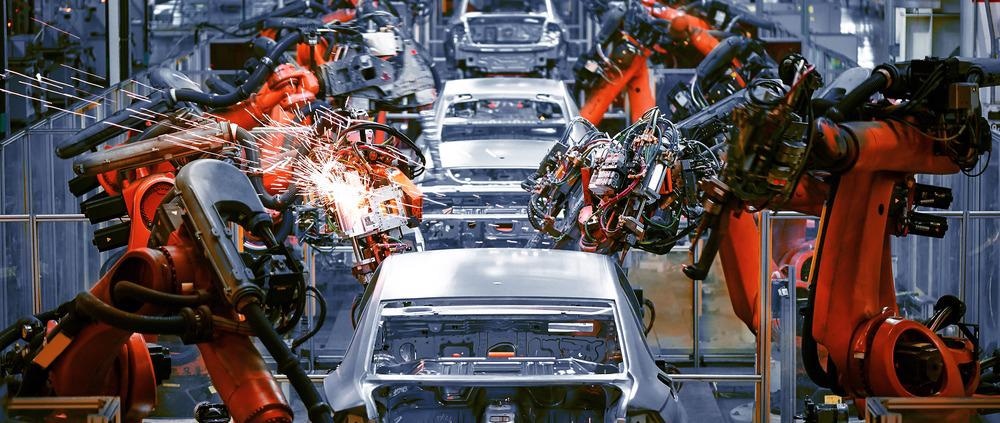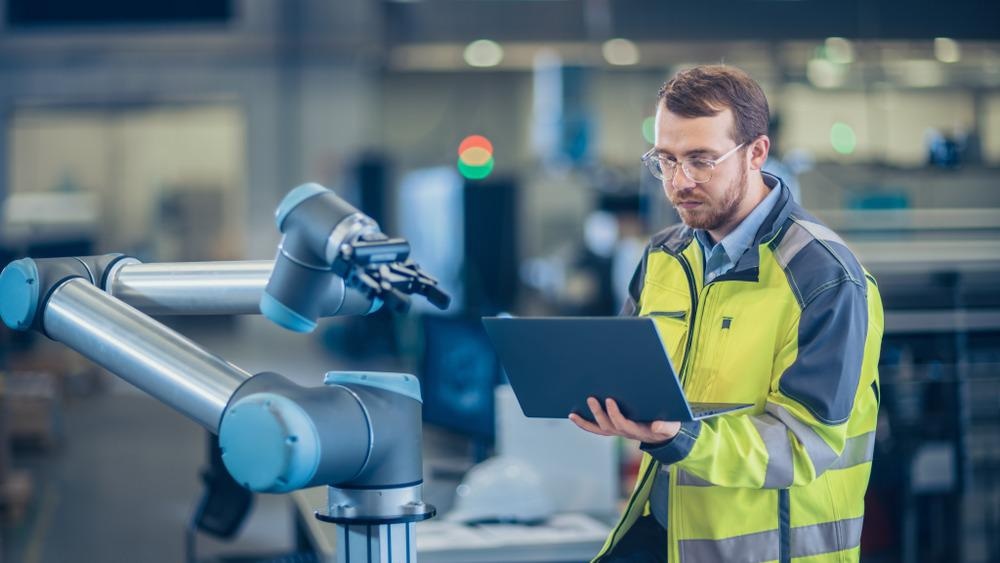Today, almost every major industry benefits from some kind of automation. From factories and telephone switchboards to smart electric grids and stock exchanges, industrial automation is omnipresent. But what is stopping even more automation across industries in the next few years?

Image Credit: Jenson/Shutterstock.com
Enabling technologies like computers and robotics led to increased applications for more sectors throughout the twentieth century, and this curve became even steeper with the onset of COVID-19. This article explores the causes behind the rise of industrial automation and looks at some of the challenges yet to be overcome.
What Is Industrial Automation?
Industrial automation applies automatic control to large-scale processes and systems. Industrial automation creates and applies machine parts and processes for input (sensors), output (robotics), infrastructure, supervisory and control systems, computer architecture, and artificial intelligence (AI).
It is used in nearly all sectors today. Swarms of intelligent agri-robots independently till the land in the vast plains of Australia and the American midwest. National electric grids around the world maintain the delicate balance of energy in a massive network with the assistance of algorithms and automatic responses. Most transactions in the stock market are made by bots.
Handing industrial decision-making over to machines can make those processes more resource-efficient, time-efficient, and labor-efficient. Ultimately, industrial automation can save money.
The rise of automation has gathered pace since the introduction of computer-based control systems to industry in the mid-twentieth century. Computing power got exponentially more powerful (and cheaper) in the following decades, and industrial automation became more widely applicable.
It is inexpensive to include computer chips, battery storage, sensors, and wireless connectivity in each component of an industrial process now, in a way that was unattainable even just a few decades ago. Many more manufacturers can take advantage of automatic processes. For example, traditionally “automation-proof” professions like medicine, law, accounting, and business management are seeing automation.
Is Industrial Automation A Good Investment?
Robots do not ask for wages. They do not need sick days, or weekends, or parental leave. Medical insurance and pension contributions are wasted on them. Human resources, personal protective equipment, training, uniforms, and bonuses are surplus to requirements.
Ron Potter, Director of Robotics Technology for Factory Automation Systems, based in Georgia, US, and Engelberger Robotics Award recipient, calculates an example $250,000 automation system could generate $1,500,000 of additional cash flow within seven or eight years.
Where Are the Savings?
A smaller wage bill is one saving achieved by industrial automation. But other efficiencies can also be made.
Reliable input and output (I/O) automation help manufacturers cut down on wasted materials; precise distributed control systems (DCSs) eliminate waiting time from the manufacturing process; supervisory control and data acquisition (SCADA) architectures reduce the risk of system failures. Machine learning (ML) and algorithmically directed process optimization find new efficiency gains for the system.
Considering the climate catastrophe facing our planet, there is a clear need to eliminate waste in our activity as much as possible. When optimized for efficiency, industrial automation consumes fewer materials, wastes fewer resources, and demands less energy.
In 2017, the US Office of Energy Efficiency & Renewable Energy reported that reliably automating controls in commercial factories and other commercial buildings could cut their energy consumption by 29%.
The Robot Revolution: The New Age of Manufacturing | Moving Upstream
Video Credit: Wall Street Journal/YouTube.com
Worker Safety, Remote Operations, and COVID-19
Industrial processes involving extremely high temperatures, fast-moving machine parts, hazardous chemicals, or repetitive, non-ergonomic tasks were among the first to get handed over to robots and automation. This early adoption of industrial automation correlates with a sharp decline in worker injury and illness, a trend that has continued into the twenty-first century.
Data-twinning projects have shifted operations in industries like aviation, manufacturing, logistics, and mining away from remote or extreme environments and into big office buildings near cities.
When these projects are handled with respect for the company's obligations towards its employees, retraining and retaining workers in new roles in data centers negates automation's social and economic displacement.
COVID-19 sped up the completion of many industrial automation projects or spurred companies on to start projects that they had been mulling over for a while.
Industrial Automation Is Still On The Rise
According to the multinational consultancy firm, Accenture, automation could increase gross value added (GVA, a measure of economic efficiency) in 12 developed economies by 200% by 2035. Labor productivity will also be spurred on, rising by up to 140% in the same time period.
The new wave of industrial automation – the self-service checkouts, robot-controlled warehouse and logistics operations, and swarms of intelligent reforesting drones unleashed in the last few years – shows no signs of slowing down. But there are yet a few challenges to overcome.

Image Credit: Gorodenkoff/Shutterstock.com
Challenges to Overcome
Consultant Sudeshna Das reported on the challenges facing industrial automation for ElectronicsForU.com in 2018 and updated the list this year.
The cost of labor is either a challenge for industries considering automation or a benefit, depending on where the labor is located. In countries with low wages, industrial automation may not be worth the cost. However, when relatively high wages are paid for low-skilled positions, industrial automation enables more savings.
Large initial investments continue to price many companies out of industrial automation, although costs keep falling. Similarly, maintenance and upgrade costs present a barrier to adoption but are coming down across the whole sector.
Regulatory approval and public perception of industrial automation may slow down adoption in some key areas. Hospitality is a clear example, where many segments of the market are only just switching to tablet-based "servers" now, mainly in response to COVID-19.
The public and regulation might take a while to get used to industrial automation in intimate settings like care homes and hospitals. The introduction of automation in these industries must be accompanied by serious attention to the role of human-to-human contact in effective care.
Finally, society needs answers to risks of the unemployment, displacement, and eventual economic upheaval posed by wide-scale industrial automation. Considering the economic benefits to companies and organizations automating their processes, society can also benefit from industrial automation – if it can be reorganized to benefit itself as a whole.
Continue reading: The Importance of Tribology in Automation.
References and Further Reading
Anandan, T. (2015) Calculating Your ROI for Robotic Automation: Cost vs. Cash Flow. A3 Robotics. Available at: https://www.automate.org/industry-insights/calculating-your-roi-for-robotic-automation-cost-vs-cash-flow
Das, S. (2021) Industrial Automation and Control: Issues and Trends. ElectronicsForU.com. Available at: https://www.electronicsforu.com/technology-trends/tech-focus/industrial-automation-control-issues-trends
BLS.gov. (2019) Employer-reported workplace injuries and illnesses. Available at: https://www.bls.gov/news.release/pdf/osh.pdf
Pilkington, B. (2019) What is the Importance of Automation in Industries? AZO Robotics. Available at: https://www.azorobotics.com/Article.aspx?ArticleID=311
Sofos, M. and R. Fares (2017) Report Delves Into the Impacts of Commercial Building Controls on Energy Savings. Energy.gov. Available at: https://www.energy.gov/eere/buildings/articles/report-delves-impacts-commercial-building-controls-energy-savings
Disclaimer: The views expressed here are those of the author expressed in their private capacity and do not necessarily represent the views of AZoM.com Limited T/A AZoNetwork the owner and operator of this website. This disclaimer forms part of the Terms and conditions of use of this website.